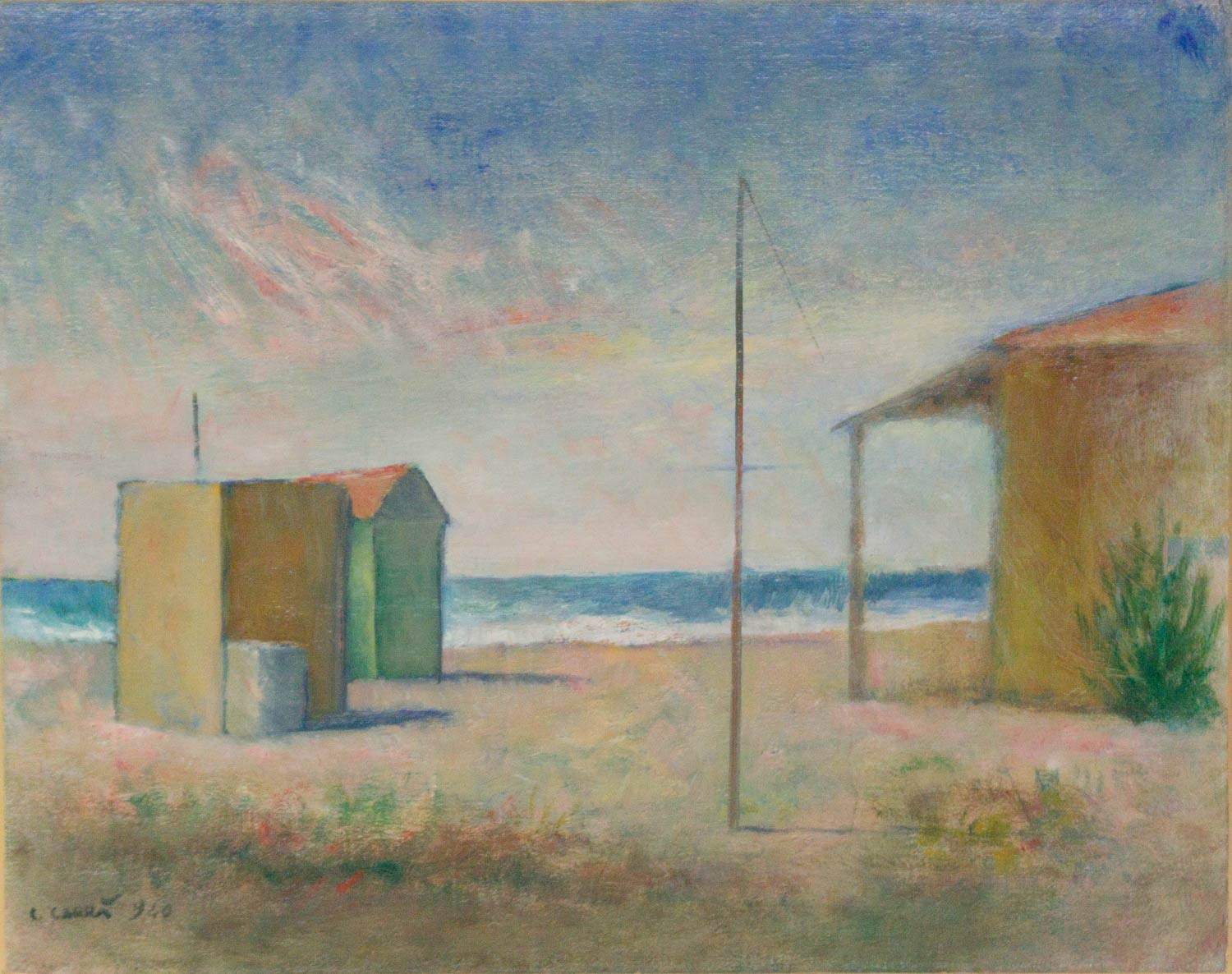It was Arturo Dazzi from Carrara who convinced Carlo Carrà to spend the summer of 1926 in Versilia. The two had met at the Venice Biennale that year: contemporaries, artists with an established path, they were going through two profoundly different moments in their respective careers. Dazzi was on his way to the pinnacle of success, there was no international exhibition where he did not exhibit, official commissions followed one after the other without interruption. Carrà had long since finished sailing among the impetuous waves of futurism, and was beginning to consider the possibility of directing in new directions the metaphysical road that, already during the years of the First World War, he had taken, in search of a more rigorous language, more solid, in some ways even more intimate. This was not enough for him: his desire was higher. He was in search of a painting that was capable of revealing a higher balance, a “higher state of being,” to use his own words: Carrà was convinced of finding in the ordinary the poetic expression of his creativity. A kind of resonance between the artist’s spirit and objective reality-a path that French and Italian painting had begun to essay in the latter part of the nineteenth century. However, Carrà wanted to go further: he was interested in exploring the elements underlying artistic activity itself.
In 1926 he then decided to leave. From then on he would never again be detached from Versilia, which he would continue to frequent for all the summers of his life: he had found there that dimension he had been searching for at least since the Pine Tree by the Sea, the painting that inaugurates this phase of Carrà’s painting, long kept in a private collection and since 2022 entered the Uffizi collection. The atmospheres that he had explored a few years earlier in Liguria lived, for Carrà, an even more intense dimension in a Versilia that at that time resembled more the splendid and solitary land of D’Annunzio alcionio than the intellectual Arcadia that it would become in the postwar period, a gathering place for poets and literati among baths and umbrellas.
For Carrà it was an enduring season: every summer he returned to Forte dei Marmi to paint the uniform mass of its beach, the shrubs dotting the dunes with green, the huts and cabins investigated in their essential forms, parallelepipeds that stand on the sand but fail to block the view of the sea. The Marina of the Giovanardi Collection in Milan fully expresses the aspirations of the post-metaphysical Carrà. Of that brief season, Carrà retains the suspended and rarefied atmosphere. There is never a human figure intervening in his landscapes. However, the sense of landscape is different. Carrà does not give voice to dreamlike views, to transfigured or mysterious realities. If anything, it is the dream that enters the landscape; the opposite does not happen. The landscape is the real one, that of his beloved Versilia, the Versilia that made Carrà fall in love with “the still wild beach, the silent pine forests like cathedrals, with the Dolomite mountains behind them, but even more so with that very singular Versilia light that has the gift of making shapes and colors magical,” as his son Massimo would recall. He suffered, however, the filter of his mental abstractions, which led him to those views so essential, so imbued with poetry, drawn almost always en plein air, because Carrà admitted the fascination that seeing the sea exerted on his creative spirit. Here, then, even the Versilia Marina becomes a kind of lyrical projection, with objects investigated in their essence: the beach that becomes a grayish mass, the cabins that become cubes, regular solids, in the middle the flagpole of a flag that gives rise to a straight line, next to it another cabin, a bush that is sum of quick, regular brush strokes, in the background the rigorously divided sea, with the white froth below and the blue expanse above, the horizon marks a sharp division between sea and sky, with the celestial mass weighted down by serious, end-of-season tones.

“My aspirations,” the painter would recall speaking of his experience in Forte dei Marmi, “were thus marked by realism, but I certainly did not abandon the concept that painting is ’a mental thing,’ as Leonardo had defined it. In this way, the proud intelligence no longer operated by overestimating itself but accorded with the living example of things. Execution, too, is thus spontaneously led to constructive reason, which in turn accords with the sensations that find light and propriety in a plastic order that I define as the supreme aim of my toil.” One might think that Carrà had been fascinated by the lesson of Cézanne: Carrà’s painting also becomes, in essence, a painting of volumes. The roots of the construction of his order, however, are also to be sought in the painting of the 15th century, in the geometries of Piero della Francesca, in the perspective boldness of Paolo Uccello, but one could look even further back, going back to the spatial rigor of Giotto. And then, from the lesson of the ancient masters Carrà also derives the sense of a painting that goes beyond the real datum to seek a higher dimension: a dimension that Carrà finds in the transfixed and calm poetry that pervades his marinas. And a poetry that separates Carrà from Cézanne, as Longhi had already noted: “Carrà opens up a different path and refusing to summarize those precedents as a sufficiency of systematic technique, he rediscovers them poetically as passages, joints and accents to be composed in a song that has to find its tone in an inclination of the soul.”
Carrà’s, suggested art historian Elena Pontiggia, is a procedure similar to that which in the same years, in literature, was being experimented with by Ungaretti: just as the poet, in his desire to leave behind that “age of debacle and exaggeration” marked by the experiences of futurism and fragmentism, intended to recover the word as a means of transforming sensations into expressions, using forms that were simple but charged with’intense tangencies, in the same way Carrà transforms reality, Pontiggia writes, into “archetypes, primordial models of what will at some point enter the flow of time.” A poem made of simple, elementary forms, hovering under the leaden sky of a late summer day on the beaches of Versilia.

The author of this article: Federico Giannini
Nato a Massa nel 1986, si è laureato nel 2010 in Informatica Umanistica all’Università di Pisa. Nel 2009 ha iniziato a lavorare nel settore della comunicazione su web, con particolare riferimento alla comunicazione per i beni culturali. Nel 2017 ha fondato con Ilaria Baratta la rivista Finestre sull’Arte. Dalla fondazione è direttore responsabile della rivista. Nel 2025 ha scritto il libro Vero, Falso, Fake. Credenze, errori e falsità nel mondo dell'arte (Giunti editore). Collabora e ha collaborato con diverse riviste, tra cui Art e Dossier e Left, e per la televisione è stato autore del documentario Le mani dell’arte (Rai 5) ed è stato tra i presentatori del programma Dorian – L’arte non invecchia (Rai 5). Al suo attivo anche docenze in materia di giornalismo culturale all'Università di Genova e all'Ordine dei Giornalisti, inoltre partecipa regolarmente come relatore e moderatore su temi di arte e cultura a numerosi convegni (tra gli altri: Lu.Bec. Lucca Beni Culturali, Ro.Me Exhibition, Con-Vivere Festival, TTG Travel Experience).
Warning: the translation into English of the original Italian article was created using automatic tools. We undertake to review all articles, but we do not guarantee the total absence of inaccuracies in the translation due to the program. You can find the original by clicking on the ITA button. If you find any mistake,please contact us.